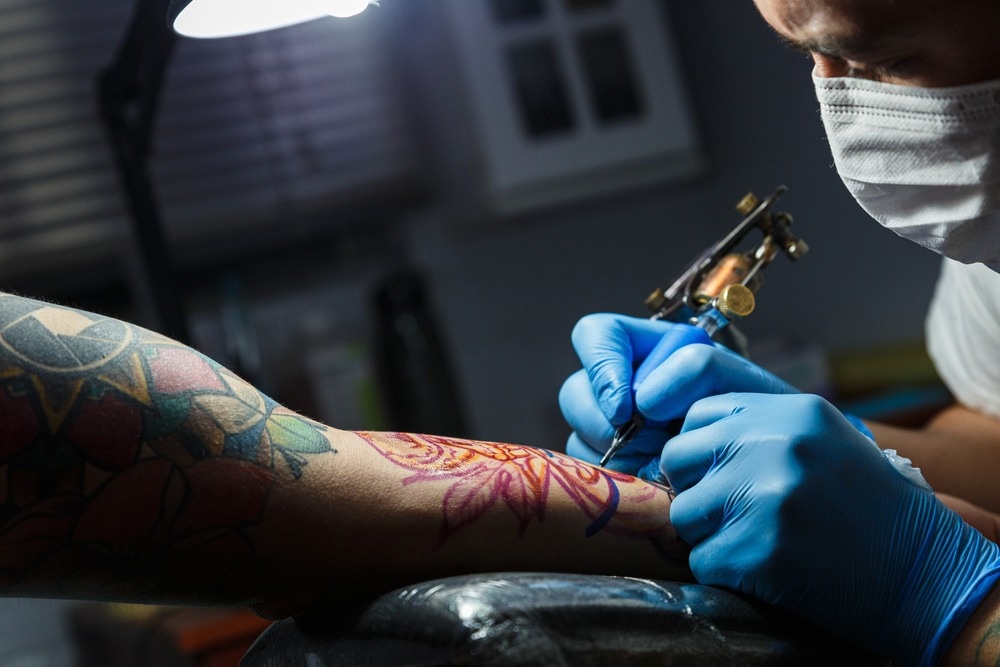A recent Medicina Clinica review paper describes the characteristics of systemic bacterial infections associated with tattoos. These adverse effects can be avoided by maintaining strict hygiene while performing a tattoo.

Study: Systemic infections associated with tattoos or permanent makeup: A systematic review. Image Credit: daniel catrihual / Shutterstock.com
Background
The practice of tattooing has been documented in ancient literature since the Neolithic period. By the 18th century, tattoos were introduced to Western culture. According to recent estimates, over 20 million Americans and 100 million Europeans have tattoos.
Tattooing is a painful process that involves the introduction of artificial pigment under the skin. If not performed hygienically, tattoos can induce various health complications, including immune and inflammatory reactions, infections, and chronic skin defects such as dermatoses. Between 2% and 27% of individuals experience some sort of discomfort after having a tattoo, with 0.5-6% developing skin infections.
In the current systematic review, scientists screen and analyze tattoo adversity-related studies to identify the causative pathogens associated with severe or fatal systemic infections.
Study design
The scientists searched articles in the PubMed database that were published between 2009 and 2019. Any studies describing tattoo-related systemic infections in humans were included in the final analysis. The pathogens identified in these studies were compared with a literature search without year restriction.
Tattoo-related systemic infection was defined as any pathogen invading the skin with or without spreading to other organs.
Important observations
The final analysis included a total of 17 studies. In contrast to the historical literature, none of the selected studies reported the development of systemic tuberculosis, syphilis, or viral infections after performing a tattoo.
Several sporadic cases of Mycobacterium leprae, which is the bacteria that causes leprosy, were identified in India. Additionally, several cases of lymph node enlargement due to non-tuberculosis mycobacteria, which do not cause tuberculosis or leprosy, were identified.
The most commonly identified non-tuberculosis mycobacteria included Mycobacterium chelonae, Mycobacterium abscessus, and Mycobacterium haemophilum. The majority of Mycobacterium haemophilum-induced systemic infections were identified in females after eyebrow tattooing, 50% of whom eventually required parotidectomy, which is the partial or complete removal of the parotid gland.
Several studies reporting septic shock associated with cellulitis or necrotizing fasciitis were identified. Septic shock was primarily associated with pyogenic bacteria and occurred within two weeks after tattooing. Death occurred in one person with Vibrio vulnificus-related septic shock.
Only one study reporting staphylococcal toxic shock syndrome was identified. This infection was observed after Samoan traditional tattoos or after tattooing in unhygienic conditions.
Infective endocarditis was identified predominantly in young men. The condition was associated with fever, as well as lung or systemic embolisms, without local symptoms. In 50% of cases, valvular anomalies were present as a known risk factor.
Massive embolization was detected in two cases, whereas leaflet perforation and perivalvular abscess were reported in two cases. Only one case with toxic shock syndrome was identified.
Several studies reporting dermatophytosis were identified during the study period; however, none reported systemic infections.
Study significance
The current study reports that systemic infections might develop after having a tattoo. However, tattoo-related fatality is a rare event, with only one death reported in the past ten years.
Historical evidence has extensively reported viral infections following tattooing. More specifically, several reports mention tattoo-related outbreaks of the human immunodeficiency virus (HIV) and hepatitis B or C virus infections.
Importantly, a shift in causative pathogens has been observed in recent times. In fact, non-tuberculosis mycobacteria have been identified as emerging bacteria causing systemic infections.
A centralized reporting system should be developed to understand the epidemiology of the phenomena. Furthermore, proper hygienic conditions should be maintained while tattooing.
Journal reference:
- Rello, J., Tejada, S., Campogiani, L., et al. (2022). Systemic infections associated with tattoos or permanent makeup: A systematic review. Medicina Clinica. doi:10.1016/j.medcle.2021.01.026.